Advances in Piezoelectric Jet and Atomization Devices
Abstract
:1. Introduction
2. Advances in Piezoelectric Micro Jet Devices
2.1. Bend Mode
2.2. Push Mode
2.3. Squeeze Mode
2.4. Shear Mode
3. Advances in Piezoelectric Atomizers
3.1. Static Mesh Atomizer
3.2. Dynamic Mesh Atomizer
4. Advances in the Application of Piezoelectric Jets and Atomizers
4.1. Cell Printing
4.2. Spray Cooling
4.3. Drug Delivery
4.4. Other Applications
5. Summary and Outlook
5.1. Summary
- (1)
- According to the constituents and status of spray material, the spray can be mainly classified into two types. When the spray material accounts for an absolute high proportion of liquid, it is defined as a spray processing, otherwise it is regard as an atomization processing.
- (2)
- The development history of four types of piezoelectric micro jet devices were summarized, and their working principles, advantages, and disadvantages were also analyzed.
- (3)
- Both the development history and structural characteristics of static mesh atomizer and dynamic mesh atomizer were scientifically reviewed. Additionally, their working mechanisms, advantages, and shortages were revealed.
- (4)
- The application of piezoelectric jet and atomization devices can be generalized from three different aspects including cell printing, spray cooling, and drug delivery.
5.2. Outlook
Author Contributions
Funding
Institutional Review Board Statement
Informed Consent Statement
Data Availability Statement
Conflicts of Interest
References
- Eggers, J.; Villermaux, E. Physics of liquid jets. Rep. Prog. Phys. 2008, 71, 036601. [Google Scholar] [CrossRef]
- Huang, X.Q.; Zhang, D.L.; Zhang, X. Stability of secondary atomization locations of atomizer nozzles for humidfication chambers. J. New Mater. Electrochem. Syst. 2019, 35, 700–706. [Google Scholar]
- Stevenin, C.; Vallet, A.; Tomas, S.; Amielh, M.; Anselmet, F. Eulerian atomization modeling of a pressure-atomized spray for sprinkler irrigation. Int. J. Heat Fluid Flow 2016, 57, 142–149. [Google Scholar] [CrossRef]
- Tushar, A.; Agisilaos, K.; Assaad, R.M. Atomization behaviour of a hybrid air-blast-electrostatic atomizer for spray combustion. Fuel 2021, 288, 119716. [Google Scholar]
- Uchino, K.J. Piezoelectric actuator renaissance. Energy Harvest. Syst. 2014, 1, 45–56. [Google Scholar] [CrossRef]
- Uchino, K.J. Introduction to piezoelectric actuators: Research misconceptions and rectifications. Jpn. J. Appl. Phys. 2019, 58, SG0803. [Google Scholar] [CrossRef] [Green Version]
- Li, G.; Su, H.; Cole, G.A.; Shang, W. Robotic system for MRI-guided stereotactic neurosurgery. IEEE Trans. Biomed. Eng. 2015, 62, 1077–1088. [Google Scholar] [PubMed] [Green Version]
- Eslami, S.; Shang, W.; Li, G.; Patel, N.; Iordachita, C.M.T.A. In-bore prostate transperineal interventions with an MRI-guided parallel manipulator: System development and preliminary evaluation. Int. J. Med. Robot. Comput. Assist. Surg. 2016, 12, 199–213. [Google Scholar] [CrossRef]
- Tavallaei, M.A.; Johnson, P.M.; Liu, J.; Drangova, M. Design and evaluation of an MRI-compatible linear motion stage. Med. Phys. 2016, 43, 62–71. [Google Scholar] [CrossRef] [Green Version]
- Chen, S.; Liu, H.D.; Ji, J.J.; Kan, J.W.; Jiang, Y.H.; Zhang, Z.H. An indirect drug delivery device driven by piezoelectric pump. Smart Mater. Struct. 2020, 29, 075030. [Google Scholar] [CrossRef]
- He, L.P.; Wu, X.Q.; Zhao, D.; Li, W. Exploration on relationship between flow rate and sound pressure level of piezoelectric pump. Microsyst. Technol. 2020, 26, 609–616. [Google Scholar] [CrossRef]
- Li, H.Y.; Liu, J.K.; Li, K.; Liu, Y.X. A review of recent studies on piezoelectric pumps and their applications. Mech. Syst. Signal Process. 2021, 151, 107393. [Google Scholar] [CrossRef]
- Zhang, J.H.; Yan, Q.F.; Sun, W.T. Advances in piezoelectric atomizers. Trans. Nanjing Univ. Aeronaut. Astronaut. 2020, 37, 54–69. [Google Scholar]
- He, W.; Luo, Z.B.; Deng, X.; Xia, Z. A novel spray cooling device based on a dual synthetic jet actuator integrated with a piezoelectric atomizer. Heat Mass Transf. 2020, 56, 1551–1563. [Google Scholar] [CrossRef]
- Hsieh, S.S.; Huang, C.F.; Lu, Y.M. Water spray heat transfer through a piezoelectric atomizer with a single-hole micronozzle. J. Mech. Sci. Technol. 2020, 34, 3427–3436. [Google Scholar] [CrossRef]
- Wu, I.P.; Chien, M.Y.; Hsiao, H.F.; Chen, E.Y.T.; Liu, Y.Y.; Chou, C.W.; Lai, S.H. Utilization of vibrating mesh nebulizer in the treatment of infants with acute. Pediatr. Respirol. Crit. Care Med. 2017, 1, 63–68. [Google Scholar]
- Roy, N.K.; Behera, D.; Dibua, O.G.; Foong, C.S.; Cullinan, M.A. Single shot, large area metal sintering with micrometer level resolution. Opt. Express 2018, 26, 25534–25544. [Google Scholar] [CrossRef]
- Moon, S.; Hasan, S.; Song, Y.; Xu, F.; Keles, H.O.; Manzur, F.; Mikkilineni, S.; Hong, J.; Nagatomi, J.; Haeggstrom, E. Layer by layer three-dimensional tissue epitaxy by cell-laden hydrogel droplets. Tissue Eng. Part C Methods 2010, 16, 157–166. [Google Scholar] [CrossRef] [PubMed]
- Carnahan, R.D.; Hou, S.L. Ink jet technology. IEEE Trans. Ind. Appl. 1977, 1, 95–104. [Google Scholar] [CrossRef]
- Brunahl, J.; Grishin, A.M. Piezoelectric shear mode drop-on-demand inkjet actuator. Sens. Actuator A 2002, 101, 371–382. [Google Scholar] [CrossRef]
- Stemme, E.; Larsson, S.G. The piezoelectric capillary injector-a new hydrodynamic method for dot pattern generation. IEEE Trans. Electron. Devices 1973, 20, 14–19. [Google Scholar] [CrossRef]
- Zhan, H.W. Dynamics modeling and ink supply methods of piezoelectric ink-jetting process. J. Mech. Eng. 2017, 53, 140–149. [Google Scholar] [CrossRef]
- Harada, T.; Ishikawa, N.; Kanda, T. Droplet generation using a torsional Langevin-type transducer and a micropore plate. Sens. Actuators A Phys. 2009, 155, 168–174. [Google Scholar] [CrossRef]
- Cheng, C.; Chen, S.; Kuo, H.; Chou, Z. The poling design of a shear mode piezoelectric actuator. J. Micromech. Microeng. 2005, 15, 2163. [Google Scholar] [CrossRef]
- Fan, K.C.; Chen, J.Y.; Wang, C.H.; Pan, W.C. Development of a drop-on-demand droplet generator for one-drop-fill technology. Sens. Actuators A Phys. 2008, 147, 649–655. [Google Scholar] [CrossRef]
- Yang, A.S.; Cheng, C.H.; Lin, C.T. Investigation of droplet-ejection characteristics for a piezoelectric inkjet printhead. Mech. Eng. Sci. 2006, 220, 435–445. [Google Scholar] [CrossRef]
- Yoo, Y.; Kim, C.S.; Park, Y.S.; Sim, W.C.; Park, C.; Joung, J.; Park, J.G.; Oh, Y. Numerical and experimental evaluation of picoliter inkjet head for micropatterning of printed electronics. Jpn. J. Appl. Phys. 2010, 49, 111–115. [Google Scholar] [CrossRef]
- Kim, B.H.; Lee, H.S.; Kim, S.W.; Kang, P.; Park, Y.S. Hydrodynamic responses of a piezoelectric driven MEMS inkjet print-head. Sens. Actuators A Phys. 2014, 210, 131–140. [Google Scholar] [CrossRef]
- Wang, X.; Xiao, X.L.; Li, Q. Effects of the ‘spring structure’ on the performance of a vibrating plate of the piezoelectric inkjet print-head. Microsyst. Technol. 2018, 24, 2949–2956. [Google Scholar] [CrossRef]
- Khalate, A.A.; Bombois, X.; Babuška, R.; Wijshoff, H.; Waarsing, R. Performance improvement of a drop-on-demand inkjet printhead using an optimization-based feedforward control method. Control Eng. Pract. 2011, 19, 771–781. [Google Scholar] [CrossRef]
- Khalate, A.A.; Bombois, X.; Ye, S.; Babuška, R.; Koekebakker, S. Minimization of cross-talk in a piezo inkjet printhead based on system identification and feedforward control. J. Micromech. Microeng. 2012, 22, 115035. [Google Scholar] [CrossRef]
- Zhou, S.G.; Xi, J.T. Simulation and experiment study on piezoelectric actuated diaphragm-drive microdroplet jetting. J. Mech. Eng. 2013, 49, 178–185. [Google Scholar] [CrossRef]
- Park, J.H.; Seo, M.Y.; Ham, Y.B.; Yun, S.N.; Kim, D.I. Study on high-output piezoelectric micropumps for application in dmfc. J. Electroceramics 2013, 30, 102–107. [Google Scholar] [CrossRef]
- Bogy, D.B.; Talke, F.E. Experimental and theoretical study of wave propagation phenomena in drop-on-demand ink jet devices. IBM J. Res. Dev. 1984, 28, 314–321. [Google Scholar] [CrossRef]
- Li, E.; Xu, Q.; Sun, J.; Fuh, J.Y.H.; Wong, Y.S.; Thoroddsen, S.T. Design and fabrication of a PET/PTFE-based piezoelectric squeeze mode drop-on-demand inkjet print-head with interchangeable nozzle. Sens. Actuators A Phys. 2010, 163, 315–322. [Google Scholar] [CrossRef]
- Rone, W.; Ben-Tzvi, P. Design and FE analysis of integrated sensing using gas compressibility for microdroplet generation. Mechatronics 2013, 23, 397–408. [Google Scholar] [CrossRef]
- Chang, J.Q.; Liu, Y.X.; Huang, B. Effects of dwell time of excitation waveform on meniscus movements for a tubular piezoelectric print-head: Experiments and mode. J. Micromechanics Microengineering 2017, 27, 075023. [Google Scholar] [CrossRef]
- Xiao, Y.; Zhang, W.; Wang, P.; Li, H. Numerical simulation and experimental research of micro-droplet generation by directly actuated piezoelectric nozzle. J. Mech. Eng. 2020, 56, 233–239. [Google Scholar]
- Bartky, S.W.; Paton, A.D.; Temple, S.R.; Michaelis, A.J. Droplet Deposition Apparatus. U.S. Patent 4879568, 7 November 1989. [Google Scholar]
- Cheng, C.; Chen, S.; Young, S.; Su, Y.; Lin, Y. Effect of poling conditions on out-of-plane displacement for a shear mode PZT actuator. Sens. Actuators A Phys. 2006, 126, 386–395. [Google Scholar] [CrossRef]
- Wijshoff, H. The dynamics of the piezo inkjet printhead operation. Phys. Rep. 2010, 491, 77–177. [Google Scholar] [CrossRef]
- de Heij, B.; van der Schoot, B.; Bo, H.; Hess, J.; Rooij, N.F.D. Characterisation of a fL droplet generator for inhalation drug therpy. Sens. Actuators A Phys. 2000, 85, 430–434. [Google Scholar] [CrossRef]
- Liu, C.G.; Zhou, Z.Y.; Wang, X.H.; Ying, Y.E. The characteristics of a piezoelectrically actuated micro jet. Piezoelectrics Acoustooptics 2001, 23, 272–274. [Google Scholar]
- Wang, G.H.; Zhou, Z.Y.; Yuan, S.M.; Liu, C.G. Theoretical and experimental analysis of droplet characteristics in piezoelectrically actuated microjet. Chin. J. Sci. Instrum. 2002, 23, 6–8. [Google Scholar]
- Wei, D.Z.; Zhang, R.J.; Wu, R.D.; Zhou, H.Y. Design of piezoelectric micro-droplet injector. J. Tsinghua Univ. Sci. Technol. 2004, 44, 1107–1110. [Google Scholar]
- Vecellio, L. The mesh nebuliser: A recent technical innovation for aerosol delivery. Breathe 2006, 2, 252–260. [Google Scholar] [CrossRef]
- Pan, C.T.; Shiea, J.; Shen, S.C. Fabrication of an integrated piezo-electric micro-nebulizer for biochemical sample analysis. J. Micromech. Microeng. 2007, 17, 659–669. [Google Scholar] [CrossRef] [Green Version]
- Jeng, Y.R.; Su, C.C.; Feng, G.H.; Peng, Y.Y. An investigation into a piezoelectrically actuated nebulizer with μEDM-made micronozzlearray. Exp. Therm. Fluid Sci. 2007, 31, 1147–1156. [Google Scholar] [CrossRef]
- Jeng, Y.R.; Tu, P.Y.; Feng, G.H.; Su, C.C.; Peng, Y.Y. PZT bimorph actuated atomizer based on high order harmonic resonance and reduced operating pressure. Sens. Actuators A Phys. 2007, 136, 434–440. [Google Scholar] [CrossRef]
- Maehara, N.; Ueha, S.; Mori, E. Influence of the vibrating system of a multipinhole-plate ultrasonic nebulizer on its performance. Rev. Sci. Instrum. 1986, 57, 2870–2876. [Google Scholar] [CrossRef]
- Maehara, N.; Ueha, S.; Mori, E. Optimum Design Procedure for Multi-Pinhole-Plate Ultrasonic Atomizer. Jpn. J. Appl. Phys. 1987, 26, 215–217. [Google Scholar] [CrossRef]
- Toda, K. Ultrasonic Vibrating Device. U.S. Patent 5,297,734, 29 March 1994. [Google Scholar]
- Toda, K.; Akimura, Y. An ultrasonic atomizing device using coupled-mode vibration. Rev. Sci. Instrum. 1994, 65, 3276–3278. [Google Scholar] [CrossRef]
- Toda, K.; Ishii, J. Operation Performance of Self-Oscillation Ultrasonic Vibrating Device for Liquid Atomization. Jpn. J. Appl. Phys. 1995, 34, 5332–5334. [Google Scholar] [CrossRef]
- Perçin, G.; Levin, L.; Khuri-Yakub, B.T. Piezoelectrically actuated droplet ejector. Rev. Sci. Instrum. 1997, 68, 4561–4563. [Google Scholar] [CrossRef] [Green Version]
- Perçin, G.; Lundgren, T.S.; Khuri-Yakub, B.T. Controlled ink-jet printing and deposition of organic polymers and solid particles. Appl. Phys. Lett. 1998, 73, 2375. [Google Scholar] [CrossRef] [Green Version]
- Perçin, G.; Khuri-Yakub, B.T. Piezoelectricallyactuated flextensional micromachined ultrasound droplet ejectors. IEEE Trans. Ultrason. Ferroelectr. Freq. Control 2002, 49, 756–766. [Google Scholar] [CrossRef] [PubMed]
- Roche, P.E.; Hansson, A.; Khuri-Yakub, B.T. Control of a drop-ejector used as photo-resist dispenser. In Proceedings of the 5th Annual International Symposium on Smart Structures and Materials, San Diego, CA, USA, 24 July 1998; Varadan, V.V., Ed.; Volume 3323, pp. 446–454. [Google Scholar]
- Lam, K.H.; Chan, H.L.W.; Luo, H.S.; Yin, Q.R.; Yin, Z.W. Piezoelectrically actuated ejector using PMN–PT single crystal. Sens. Actuators A Phys. 2005, 121, 197–202. [Google Scholar] [CrossRef]
- Shen, S.C. A new cymbal-shaped high power microactuator for nebulizer application. Microelectron. Eng. 2010, 87, 89–97. [Google Scholar] [CrossRef]
- Cai, Y.F.; Zhang, J.H.; Zhu, C.L.; Huang, J.; Jiang, F. Theoretical Calculations and Experimental Verification for the Pumping Effect Caused by the Dynamic Micro-tapered Angle. Chin. J. Mech. Eng. 2016, 29, 615–623. [Google Scholar] [CrossRef]
- Lu, C.F.; Fu, C.C.; Yang, J.C.; Chen, C.J.; Cheng, C.H. Traveling wave driven micro-dispenser for CPU cooling application. In Proceedings of the 2006 IEEE Ultrasonics Symposium, Vancouver, BC, Canada, 27 January 2006; IEEE: New York, NY, USA, 2006; pp. 54–57. [Google Scholar]
- Yan, Q.F.; Zhang, J.H.; Huang, J.; Wang, Y. The Effect of Vibration Characteristics on the Atomization Rate in a Micro-Tapered Aperture Atomizer. Sensors 2018, 18, 934. [Google Scholar] [CrossRef] [Green Version]
- Yan, Q.F.; Wu, C.Y.; Zhang, J.H. Effect of the Dynamic Cone Angle on the Atomization Performance of a Piezoceramic Vibrating Mesh Atomizer. Appl. Sci. 2019, 9, 1836. [Google Scholar] [CrossRef] [Green Version]
- Yan, Q.F.; Sun, W.F.; Zhang, J.H. Study on the Influencing Factors of the Atomization Rate in a Piezoceramic Vibrating Mesh Atomizer. Appl. Sci. 2020, 10, 2422. [Google Scholar] [CrossRef] [Green Version]
- Huang, Y.L.; Chang, S.H. Micro-Droplets Atomizer Using PZT Ring Actuator. J. Mech. 2010, 26, 423–429. [Google Scholar] [CrossRef]
- Tse, C.; Whiteley, R.; Yu, T.; Stringer, J.; MacNeil, S.; Haycock, J.W.; Smith, P.J. Inkjet printing Schwann cells and neuronal analogue NG108-15 cells. Biofabrication 2016, 8, 015017. [Google Scholar] [CrossRef]
- Lorber, B.; Hsiao, W.K.; Hutchings, I.M.; Martin, K.R. Adult rat retinal ganglion cells and glia can be printed by piezoelectric inkjet printing. Biofabrication 2014, 6, 015001. [Google Scholar] [CrossRef]
- Lorber, B.; Hsiao, W.K.; Martin, K.R. Three-dimensional printing of the retina. Curr. Opin. Ophthalmol. 2016, 27, 262–267. [Google Scholar] [CrossRef]
- Gross, A.; Schondube, J.; Niekrawitz, S.; Streule, W.; Riegger, L.; Zengerle, R.; Koltay, P. Single-cell printer: Automated, on demand, and label free. Jala 2013, 18, 504–518. [Google Scholar] [CrossRef] [PubMed]
- Stumpf, F.; Schoendube, J.; Gross, A.; Rath, C.; Niekrawietz, S.; Koltay, P.; Roth, G. Single-cell PCR of genomic DNA enabled by automated single-cell printing for cell isolation. Biosens. Bioelectron. 2015, 69, 301–306. [Google Scholar] [CrossRef] [PubMed]
- Fujita, S.; Onuki-Nagasaki, R.; Fukuda, J.; Enomoto, J.; Miyake, M. Development of super-dense transfected cell microarrays generated by piezoelectric inkjet printing. Lab Chip 2013, 13, 77–80. [Google Scholar] [CrossRef] [PubMed]
- Koo, Y.; Kim, G. New strategy for enhancing in situ cell viability of cell-printing process via piezoelectric transducer-assisted three-dimensional printing. Biofabrication 2016, 8, 025010. [Google Scholar] [CrossRef] [PubMed]
- Lee, K.B.; Kelbauskas, L.; Brunner, A.; Meldrum, D.R.; Michiya, M. A versatile method for dynamically controlled patterning of small populations of epithelial cells on substrates via non-contact piezoelectric inkjet printing. PLoS ONE 2017, 12, e0176079. [Google Scholar] [CrossRef] [Green Version]
- Jafari, M.; Jowkar, S.; Morad, M.R. Low flow rate spray cooling by a flow blurring injector. Int. Commun. Heat Mass Transf. 2021, 122, 105168. [Google Scholar] [CrossRef]
- Heffington, S.N.; Glezer, A. Two-phase thermal management using a small-scale, heat transfer cell based on vibration-induced droplet atomization. Therm. Thermomech. Phenom. Electron. Syst. 2004, 2, 90–94. [Google Scholar]
- Soriano, G.E.; Zhang, T.L.; Alvarado, J.L. Study of the effects of single and multiple periodic doplet impingements on liquid film heat transfer. Int. J. Heat Mass Transf. 2014, 77, 449–463. [Google Scholar] [CrossRef]
- Chen, H.; Cheng, W.L.; Peng, Y.H.; Zhang, W.W.; Jiang, L.J. Experimental study on optimal spray paraameters of piezoelectric atomizer based spray cooling. Int. J. Heat Mass Transf. 2016, 103, 57–65. [Google Scholar] [CrossRef] [Green Version]
- Chen, H.; Cheng, W.L.; Zhang, W.W.; Peng, Y.H.; Jiang, L.J. Energy saving evaluation of a novel energy system based on spray cooling for supercomputer center. Energy 2017, 141, 304–315. [Google Scholar] [CrossRef]
- Chen, H.; Cheng, W.L.; Peng, Y.H.; Jiang, L.J. Dynamic Leidenforst temperature increase of impacting droplets containing high-alcohol surfactant. Int. J. Heat Mass Transf. 2018, 118, 1160–1168. [Google Scholar] [CrossRef]
- Cai, Y.F.; Zhu, C.L. Study on cooling performance of piezoelectric micro-aperture atomizer. Refrig. Air Cond. 2019, 33, 221–227. [Google Scholar]
- Waghule, T.; Singhvig, G.; Dubey, S.K.; Pandey, M.M.; Gupta, G.; Singh, M.; Dua, K. Microneedles: A smart approach and increasing potential for transdermal drug delivery system. Biomed. Pharmacother. 2019, 109, 1249–1258. [Google Scholar] [CrossRef] [PubMed]
- Kouiavskia, D.; Mirochnitchenko, O.; Dragunsky, E.; Kochba, E.; Levin, Y.; Troy, S.; Chumakov, K. Intradermal inactivated poliovirus vaccine: A preclinical dose-finding study. J. Infect. Dis. 2015, 211, 1447–1450. [Google Scholar] [CrossRef] [PubMed] [Green Version]
- Troy, S.B.; Kouiavskaia, D.; Siik, J.; Kochba, E.; Beydoun, H.; Mirochnitchenko, O.; Levin, Y.; Khardori, N.; Chumakov, K.; Maldonado, Y. Comparison of the immunogenicity of various booster doses of inactivated polio vaccine delivered intradermally versus intramuscularly to HIV-infected adults. J. Infect. Dis. 2015, 211, 1969–1976. [Google Scholar] [CrossRef] [Green Version]
- Levin, Y.; Kochba, E.; Kenney, R. Clinical evaluation of a novel microneedle device for intradermal delivery of an influenza vaccine: Are all delivery methods the same? Vaccine 2014, 32, 4249–4252. [Google Scholar] [CrossRef]
- Jin, X.; Zhu, D.D.; Chen, B.Z.; Ashfaq, M.; Guo, X.D. Insulin delivery systems combined with microneedle technology. Adv. Drug Deliv. Rev. 2018, 127, 119–137. [Google Scholar] [CrossRef]
- Yu, J.; Zhang, Y.; Ye, Y.; Disanto, R.; Sun, W.; Ranson, D.; Ligler, F.S.; Buse, J.B.; Gu, Z. Microneedle-array patches loaded with hypoxia-sensitive resicles provide fast glucose-responsive insulin delivery. Proc. Natl. Acad. Sci. USA 2015, 112, 8260–8265. [Google Scholar] [CrossRef] [PubMed] [Green Version]
- Veiseh, O.; Langer, R. Diabetes: A smart insulin patch. Nature 2015, 524, 39–40. [Google Scholar] [CrossRef]
- Dogra, S.; Yadav, S.; Sarangal, R. Microneedling for acne scars in Asian skin type: An effective low cost treatment modality. J. Cosmet. Dermatol. 2015, 13, 180–187. [Google Scholar] [CrossRef]
- Kontochistopoulos, G.; Kouris, A.; Platsidaki, E.; Markantoni, V.; Antoniou, C. Combination of microneedling and 10% trichloroacetic acid peels in the management of infraorbital dark circles. J. Cutan. Laser Ther. 2016, 18, 289–292. [Google Scholar] [CrossRef] [PubMed]
- Khater, M.H.; Khattab, F.M.; Abdelhaleem, M.R. Treatment of striae distensae with needling therapy versus CO2 fractional laser. J. Cosmet. Laser Ther. 2016, 18, 75–79. [Google Scholar] [CrossRef] [PubMed]
- Allen, E.A.; O’Mahony, C.; Cronin, M.; O’Mahony, T.; Crean, A.M. Dissolvable microneedle fabrication using piezoelectric dispensing technology. Int. J. Pharm. 2016, 500, 1–10. [Google Scholar] [CrossRef] [PubMed]
- O’Mahony, C.; Hilliard, L.; Kosch, T.; Bocchino, A.; Sulas, E.; Kenthao, A.; O’Callaghan, S.; Clover, A.J.P.; Demarchi, D.; Bared, G. Accuracy and feasibility of piezoelectric inkjet coating technology for applications in microneedle-based transdermal delivery. Microelectron. Eng. 2017, 172, 19–25. [Google Scholar] [CrossRef]
- Boehm, R.D.; Miller, P.R.; Daniels, J.; Stafslien, S.; Narayan, R.J. Inkjet printing for pharmaceutical applications. Mater. Today 2014, 17, 247–252. [Google Scholar] [CrossRef]
- Boehm, R.D.; Daniels, J.; Stafslien, S.; Nasir, A.; Lefebvre, J.; Narayan, R.J. Polyglycolic acid microneedles modified with inkjet-deposited antifungal coatings. Biointerphases 2015, 10, 011004. [Google Scholar] [CrossRef] [Green Version]
- Boehm, R.D.; Jaipan, P.; Skoog, S.A.; Stafslien, S.; Vanderwal, L.; Narayan, R.J. Inkjet deposition of itraconazole onto poly (glycolic acid) microneedle arrays. Biointerphases 2016, 11, 011008. [Google Scholar] [CrossRef] [PubMed]
- Scoutaris, N.; Chai, F.; Maurel, B.; Sobocinski, J.; Zhao, M.; Moffat, J.G.; Craig, D.Q.; Martel, B.; Blanchemain, N.; Douroumis, D. Development and Biological Evaluation of Inkjet Printed Drug Coatings on Intravascular Stent. Mol. Pharm. 2016, 13, 125–133. [Google Scholar] [CrossRef] [PubMed]
- Uddin, M.J.; Scoutaris, N.; Klepetsanis, P.; Chowdhry, B.; Prausnitz, M.R.; Douroumis, D. Inkjet printing of transdermal microneedles for the delivery of anticancer agents. Int. J. Pharm. 2015, 494, 593–602. [Google Scholar] [CrossRef] [PubMed] [Green Version]
- Beck-Broichsitter, M.; Kleimann, P.; Gessler, T. Nebulization performance of biodegradable sildenafil-loaded nanoparticles using the Aeroneb Pro: Formulation aspects and nanoparticle stability to nebulization. Int. J. Pharm. 2012, 422, 398–408. [Google Scholar] [CrossRef] [PubMed]
- Wen, T.; Luo, D.; Ji, Y.; Zhong, P. Development of a piezoelectric-based odor reproduction system. Electronics 2019, 8, 870. [Google Scholar] [CrossRef] [Green Version]
- Nicola, U.; Antonio, D.M.; Fabiana, C.; Valentina, N.; Maria, B.C.T.; Valentina, P.; Salvatore, T.; Ekaterina, P.; Ekaterina, P.; Annalisa, A.; et al. A Novel, Portable MESH Nebulizer-An Alternative to Metered Dose Inhaler: Efficacy and Usability in Preschool Wheezers. Front. Pediatr. 2020, 8, 598690. [Google Scholar]
- Xiang, D.; Qu, D.G.; Mou, P.; Wang, H.; Liu, N. Research on the spray cone’s characteristics of the photoresist saving-oriented ultrasonic atomizing spraying process. J. Mech. Eng. 2013, 49, 13–20. [Google Scholar] [CrossRef]
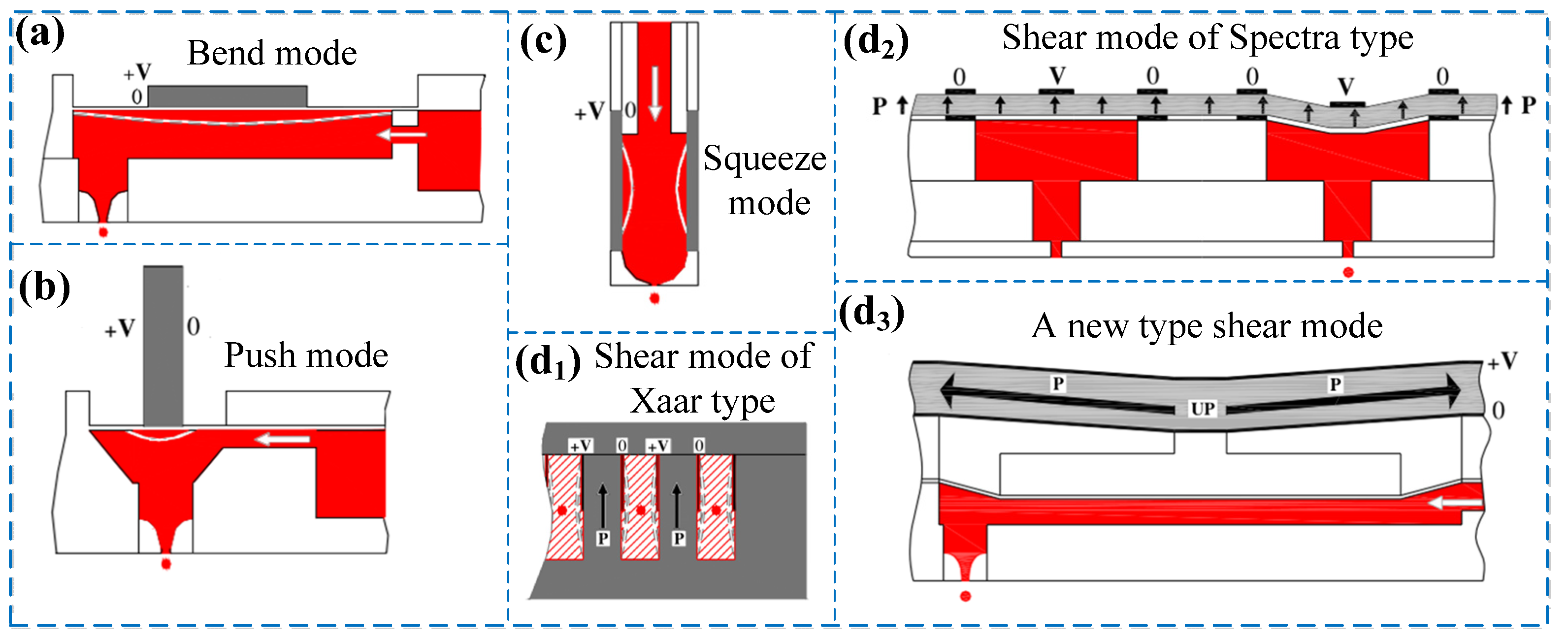
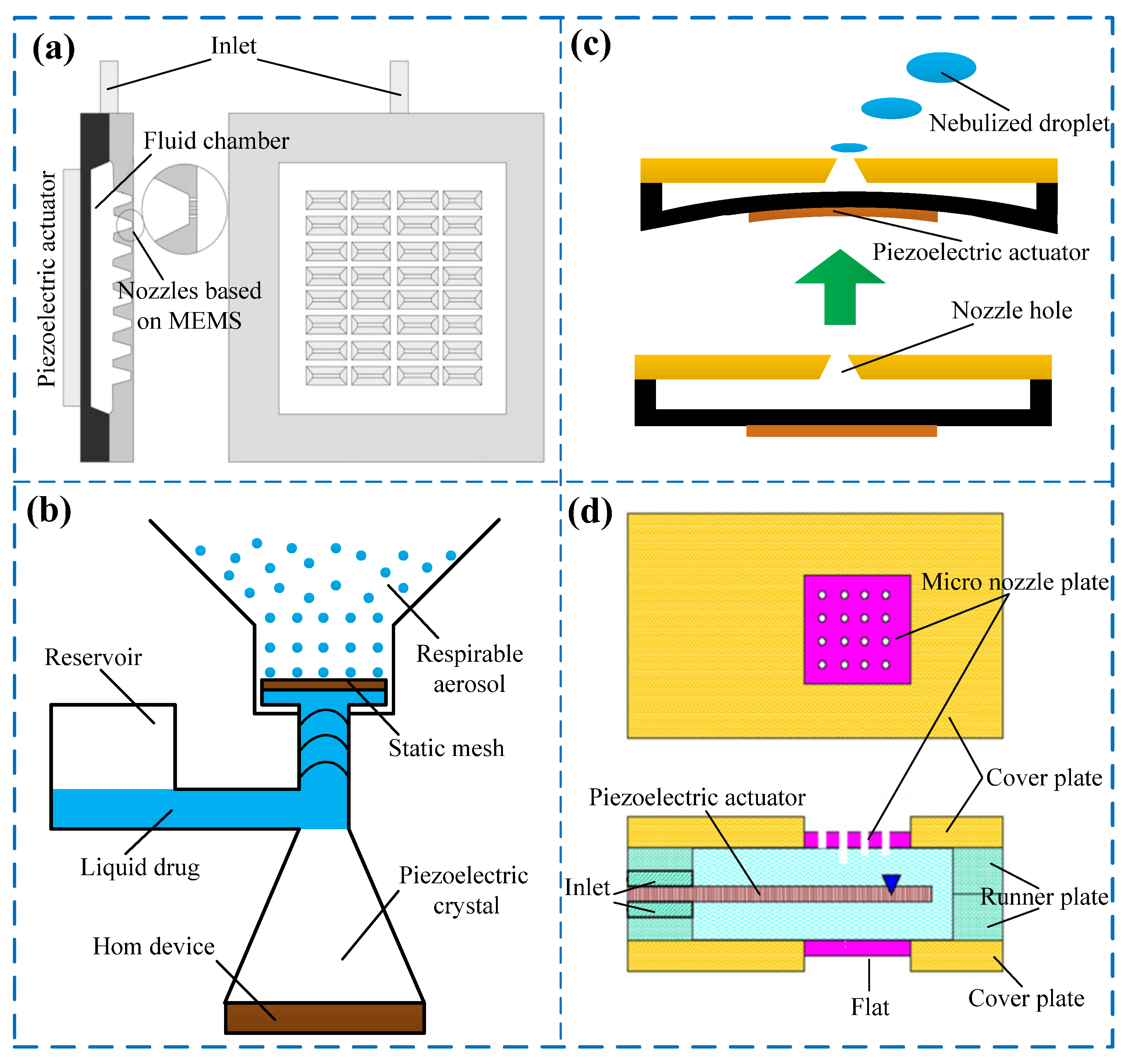
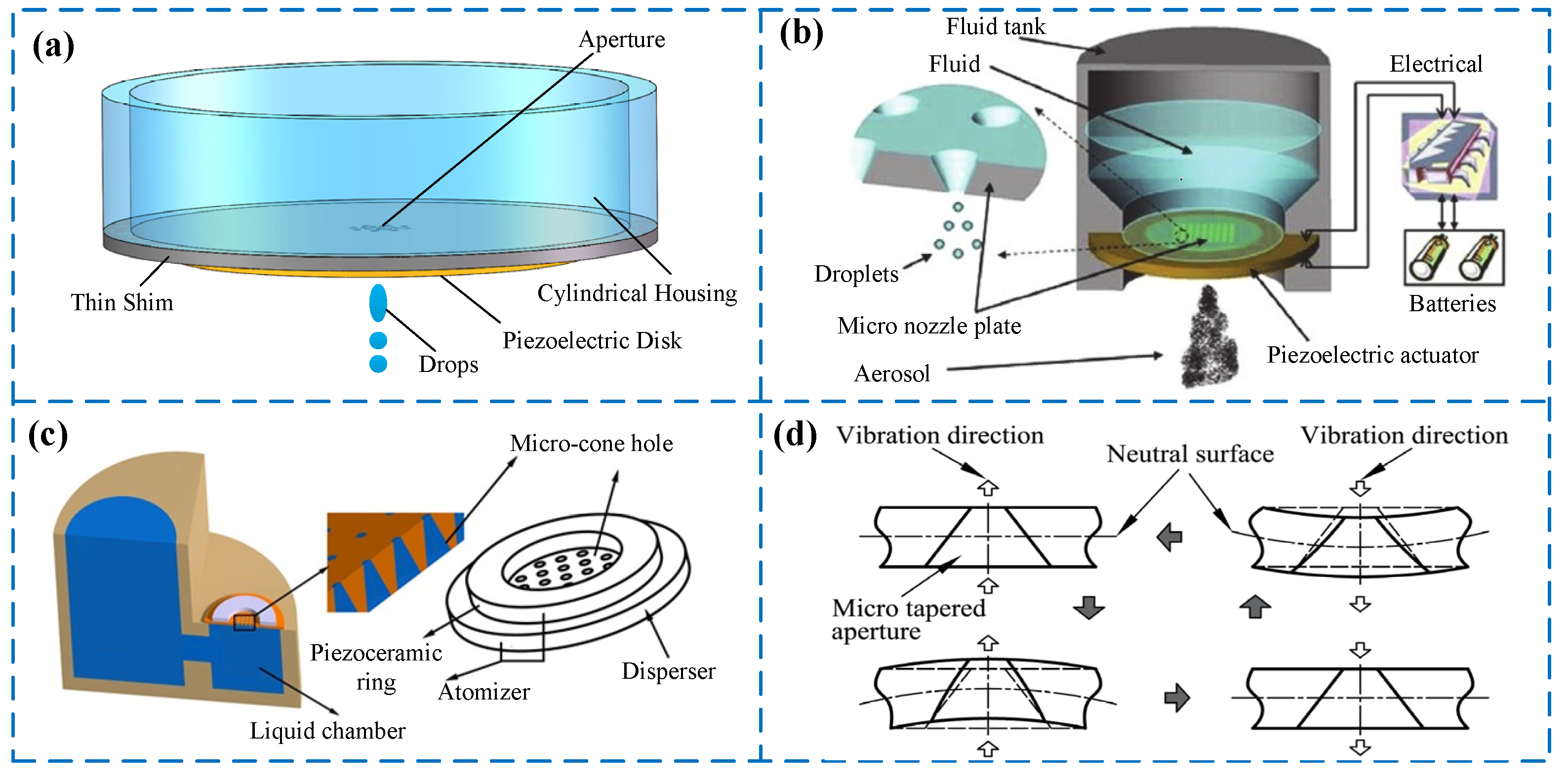
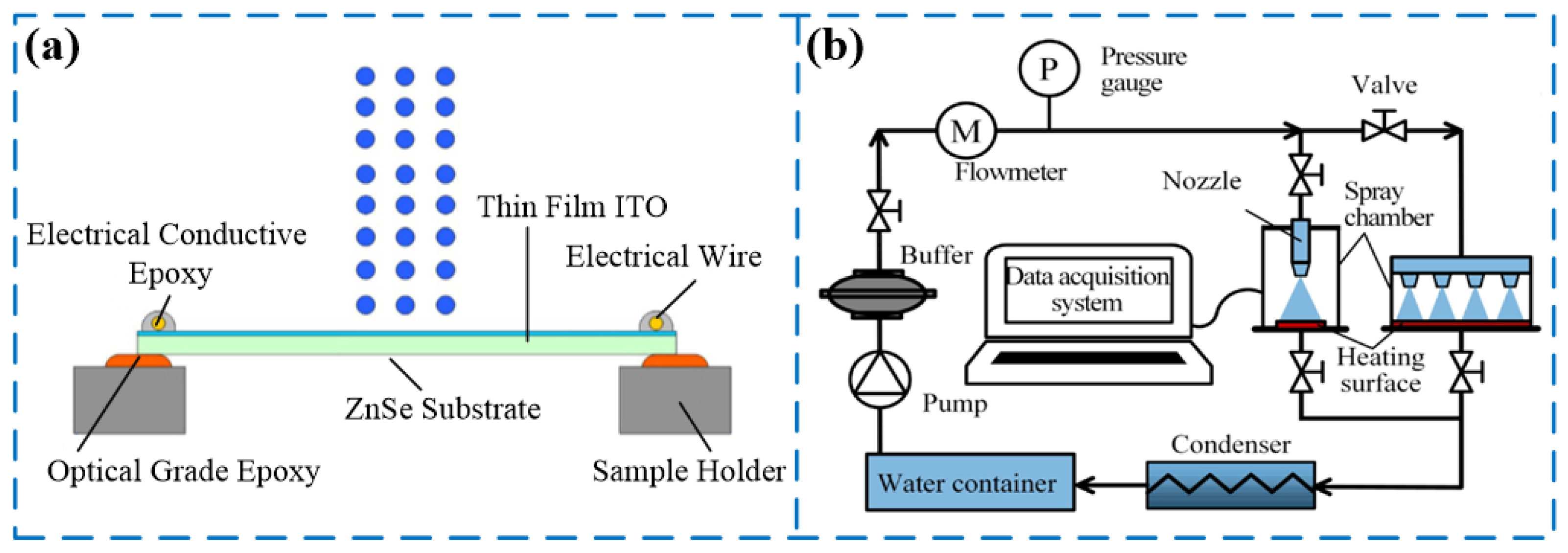
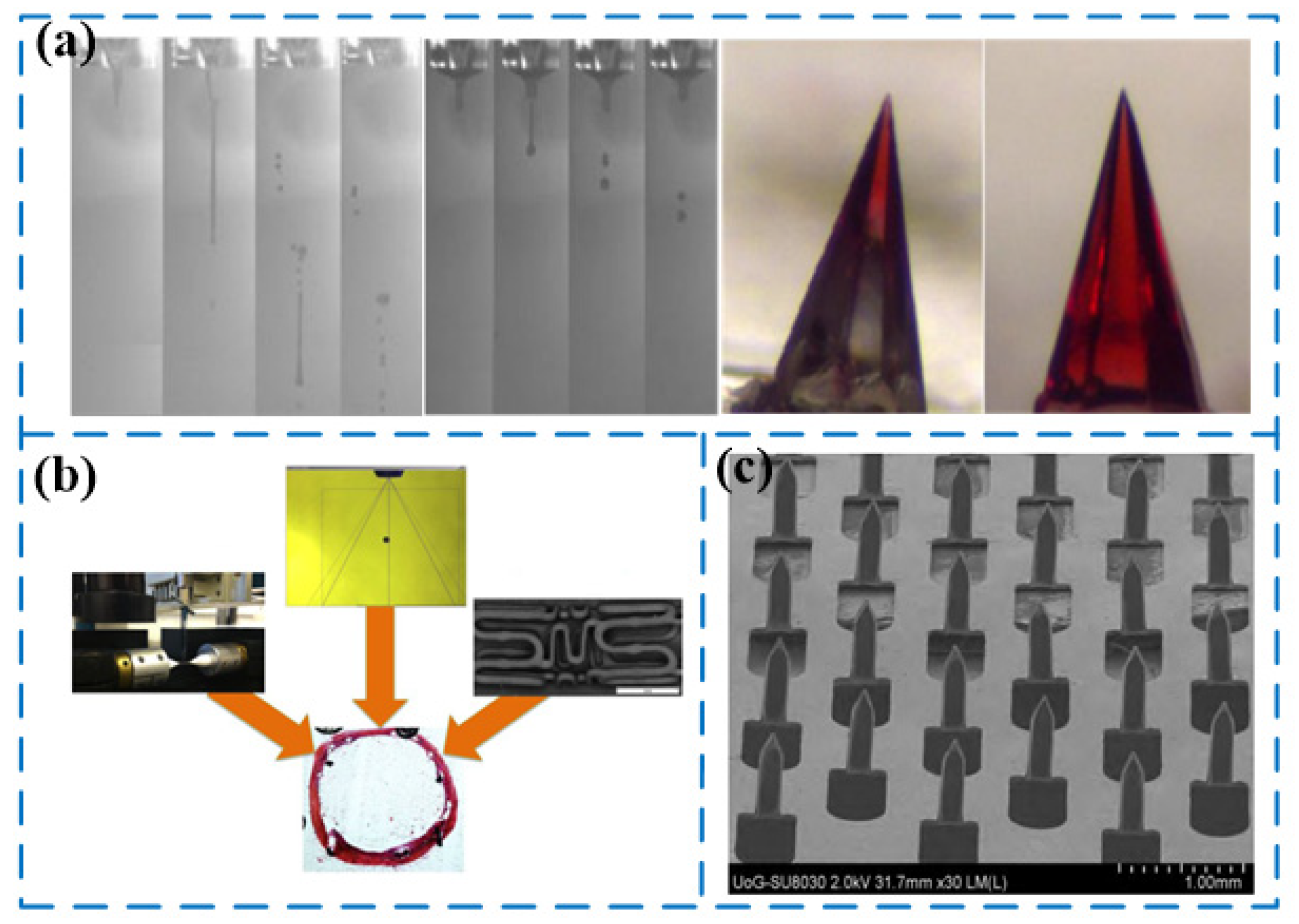
| Type | Working Principle | Advantage/Disadvantage | Application |
|---|---|---|---|
| Static mesh atomizer | The vibration of the piezoelectric vibrator is adopted to change the pressure inside the liquid cavity. When the pressure in the cavity is sufficiently large, the liquid is ejected from the micro-jetting hole, resulting in atomization. | Atomization process is controllable, and the droplets are uniformly distributed, exhibiting a complex structure. | Spray cooling, inkjet printing, inhalation therapy. |
| Dynamic mesh atomizer | Under the vibration of the piezoelectric vibrator, the droplet is broken and refined repeatedly by adjusting the balance of inertia force and capillary force, to thereby obtain atomization. | Atomization process is controllable, and the structure is relatively simple, with high energy utilization. | Spray cooling, cell printing drug delivery, produce photoresist polymer film. |
| First Author and Year | Working Frequency (kHz) | Working Voltage (V) | Atomization Rate (mL/min) | Particle Size (W) | Atomization Medium |
|---|---|---|---|---|---|
| 2000 [42] Heij | 250.0 | N/A | 1.2 | 4.7 | Water |
| 2001 [43] Liu | 200.0 | N/A | 0.6 | 5.0 | Water |
| 2002 [44] Wang | 36.0 | 80.0 | N/A | 9.94 | Deionized water |
| 2004 [45] Wei | 0.4–1.0 | N/A | N/A | N/A | Water |
| 2006 [46] Vecellio | 180.0 | 220.0 | 7.0 | N/A | Water |
| 2007 [47] Pan | 16.0 | N/A | 1.8 | 6.13 | Water |
| 2007 [48] Jeng | 18.0 | 20.0 | 1.6 | N/A | Water |
| First Author and Year | Working Frequency (kHz) | Working Voltage (V) | Atomization Rate (mL/min) | Power Dissipation (W) | Atomization Medium |
|---|---|---|---|---|---|
| 1987 [51] Maehara | 42.0 | 50.0 | 28.0 | N/A | Water |
| 1994 [52] Tode | N/A | 70.0 | 0.6 | 72.0 | Water |
| 1997 [56] Perçin | 1.2 | N/A | 0.228 | 120.0 | Water |
| 2006 [62] Lu | 50.0 | 60.0 | 27.0 | 2.75 | Water |
| 2008 [60] Shen | 120.0 | 3.0 | 0.5 | 1.2 | Water |
| 2010 [66] Huang | 31.0 | 50.0 | 64.3 | 8.24 | Water |
| 2016 [61] Cai | 113.6 | 50.0 | 0.70 | N/A | Water |
| 2018 [63] Yan | 121.1 | 80.0 | 0.56 | N/A | Water |
Publisher’s Note: MDPI stays neutral with regard to jurisdictional claims in published maps and institutional affiliations. |
© 2021 by the authors. Licensee MDPI, Basel, Switzerland. This article is an open access article distributed under the terms and conditions of the Creative Commons Attribution (CC BY) license (https://creativecommons.org/licenses/by/4.0/).
Share and Cite
Yan, Q.; You, J.; Sun, W.; Wang, Y.; Wang, H.; Zhang, L. Advances in Piezoelectric Jet and Atomization Devices. Appl. Sci. 2021, 11, 5093. https://doi.org/10.3390/app11115093
Yan Q, You J, Sun W, Wang Y, Wang H, Zhang L. Advances in Piezoelectric Jet and Atomization Devices. Applied Sciences. 2021; 11(11):5093. https://doi.org/10.3390/app11115093
Chicago/Turabian StyleYan, Qiufeng, Jiahan You, Wanting Sun, Ying Wang, Hongmei Wang, and Lei Zhang. 2021. "Advances in Piezoelectric Jet and Atomization Devices" Applied Sciences 11, no. 11: 5093. https://doi.org/10.3390/app11115093
APA StyleYan, Q., You, J., Sun, W., Wang, Y., Wang, H., & Zhang, L. (2021). Advances in Piezoelectric Jet and Atomization Devices. Applied Sciences, 11(11), 5093. https://doi.org/10.3390/app11115093







